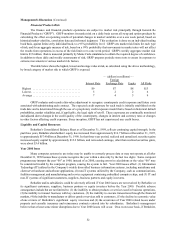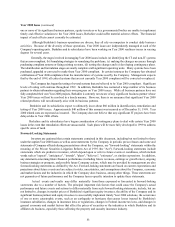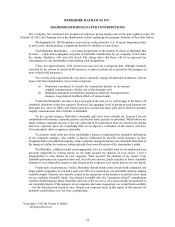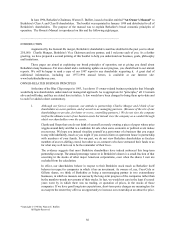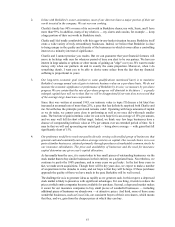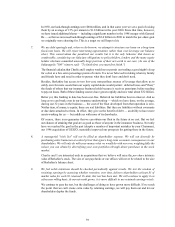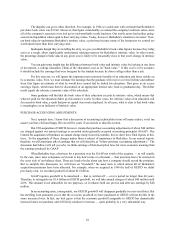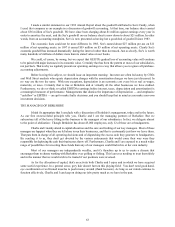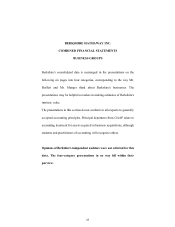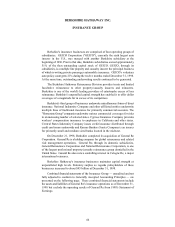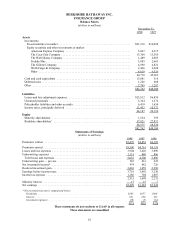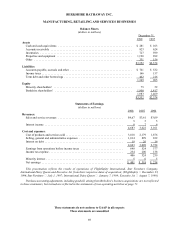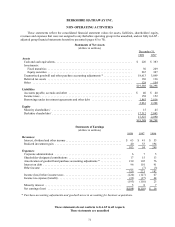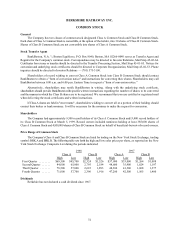Berkshire Hathaway 1998 Annual Report Download - page 63
Download and view the complete annual report
Please find page 63 of the 1998 Berkshire Hathaway annual report below. You can navigate through the pages in the report by either clicking on the pages listed below, or by using the keyword search tool below to find specific information within the annual report.62
The disparity can go in either direction. For example, in 1964 we could state with certitude that Berkshire's
per-share book value was $19.46. However, that figure considerably overstated the company's intrinsic value, since
all of the company's resources were tied up in a sub-profitable textile business. Our textile assets had neither going-
concern nor liquidation values equal to their carrying values. Today, however, Berkshire's situation is reversed: Now,
our book value far understates Berkshire's intrinsic value, a point true because many of the businesses we control are
worth much more than their carrying value.
Inadequate though they are in telling the story, we give you Berkshire's book-value figures because they today
serve as a rough, albeit significantly understated, tracking measure for Berkshire's intrinsic value. In other words,
the percentage change in book value in any given year is likely to be reasonably close to that year's change in intrinsic
value.
You can gain some insight into the differences between book value and intrinsic value by looking at one form
of investment, a college education. Think of the education's cost as its "book value." If this cost is to be accurate,
it should include the earnings that were foregone by the student because he chose college rather than a job.
For this exercise, we will ignore the important non-economic benefits of an education and focus strictly on
its economic value. First, we must estimate the earnings that the graduate will receive over his lifetime and subtract
from that figure an estimate of what he would have earned had he lacked his education. That gives us an excess
earnings figure, which must then be discounted, at an appropriate interest rate, back to graduation day. The dollar
result equals the intrinsic economic value of the education.
Some graduates will find that the book value of their education exceeds its intrinsic value, which means that
whoever paid for the education didn't get his money's worth. In other cases, the intrinsic value of an education will
far exceed its book value, a result that proves capital was wisely deployed. In all cases, what is clear is that book value
is meaningless as an indicator of intrinsic value.
PURCHASE-ACCOUNTING ADJUSTMENTS
Next: spinach time. I know that a discussion of accounting technicalities turns off many readers, so let me
assure you that a full and happy life can still be yours if you decide to skip this section.
Our 1996 acquisition of GEICO, however, means that purchase-accounting adjustments of about $40 million
are charged against our annual earnings as recorded under generally accepted accounting principles (GAAP). Our
General Re acquisition will produce an annual charge many times this number, but we don’t have final figures at this
time. So the magnitude of these charges makes them a subject of importance to Berkshire. In our annual reports,
therefore, we will sometimes talk of earnings that we will describe as "before purchase-accounting adjustments." The
discussion that follows will tell you why we think earnings of that description have far more economic meaning than
the earnings produced by GAAP.
When Berkshire buys a business for a premium over the GAAP net worth of the acquiree — as will usually
be the case, since most companies we'd want to buy don't come at a discount — that premium has to be entered on
the asset side of our balance sheet. There are loads of rules about just how a company should record the premium.
But to simplify this discussion, we will focus on "Goodwill," the asset item to which almost all of Berkshire's
acquisition premiums have been allocated. For example, when we acquired in 1996 the half of GEICO we didn't
previously own, we recorded goodwill of about $1.6 billion.
GAAP requires goodwill to be amortized — that is, written off — over a period no longer than 40 years.
Therefore, to extinguish our $1.6 billion in GEICO goodwill, we will take annual charges of about $40 million until
2036. This amount is not deductible for tax purposes, so it reduces both our pre-tax and after-tax earnings by $40
million.
In an accounting sense, consequently, our GEICO goodwill will disappear gradually in even-sized bites. But
the one thing I can guarantee you is that the economic goodwill we have purchased at GEICO will not decline in the
same measured way. In fact, my best guess is that the economic goodwill assignable to GEICO has dramatically
increased since our purchase and will likely continue to increase — quite probably in a very substantial way.


